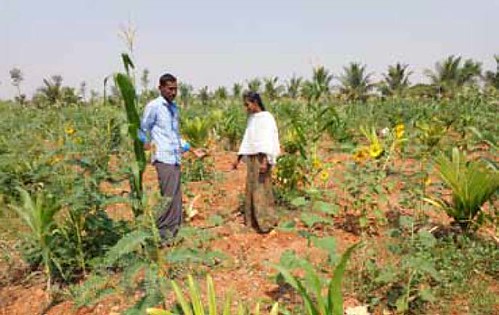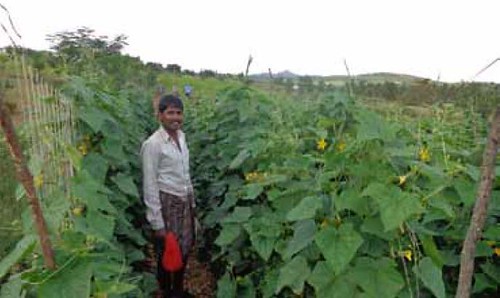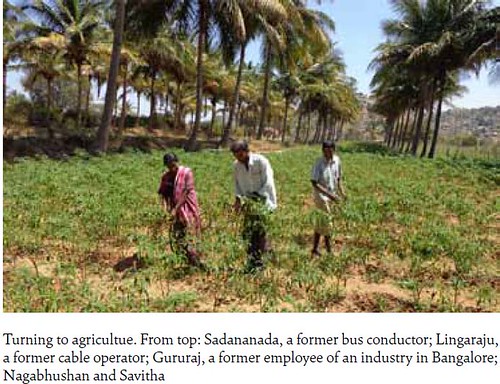Source
Media campaign for climate justice Compilation of monographs from the 2014-15 media project of Pipal Tree
The cost of cultivation is going up day after day. This is mainly due to the increased cost of inputs like seeds, fertilizers, pesticides, insecticides and labor, and the declining average yield regardless of the application of fertilizers and pesticides.
Farmers are now aware of the harmful effects of excessive application of chemical fertilizers, pesticides and insecticides on beneficial soil organisms and native plant species. However the damage is already done. With unproductive soil and declining yield farmers are getting into debt traps forcing many to commit suicide.
The primiary issue with agriculture today is the unavailability of adequate labor, lack of market facilities, lack of attractive prices for the produce and the alarming change in rainfall pattern. As a consequence, farmers are losing hope in agriculture as a viable livelihood due to the number of factors working against them.
Often, the youth in the village are attracted by city life and migrate to cities and towns in search of alternative livelihoods. The only people left in the village are the aged population and many of them are unable to continue with agriculture.
The national sample survey organization has estimated that about 40% of farmers are expected to give up agriculture and move to cities in the next two decades. This will put agriculture and food security at risk. The migration of large number of people from villages to cities will mean increased traffic, creation of new slums and much more garbage. All of this will result in an increased level of greenhouse gases (GHG) in the atmosphere.
Migration of farmers from villages to towns also means that the cultivable land is left fallow and unproductive, consequently affecting food security at family and village levels with possible impact on food security at the national level.
‘There is always light at the end of the tunnel’, so goes a saying. This is true in the case of agriculture as well. There are several instances of educated people coming back to villages to settle down and practice agriculture in their own way adopting innovative methods - organic farming, planting horticulture, timber trees, forestry trees, fodder trees, conserving natural resources, harvesting rain water, growing green manure trees, bee keeping, adopting traditional moisture management practices, etc.
Knowingly or unknowingly, these people are contributing towards mitigation of climate change through their environment friendly approaches.
Cases illustrating the new trend
The Journey of Paramashivaiah to return to agriculture
Sri Paramashivaiah is a native of Ippadi village, Kunigal taluka, Tumkur district, Karnataka. He joined a company in Mysore immediately after completion of a Job Oriented Courseand worked for this company from 2004 to 2006 for a salary of Rs. 4000 per month.
He left this company and travelled to Bangalore for a better job and salary. He ended up working as a mechanic in a press office earning Rs. 6000 per month. He got married to Umadevi, a resident of Bangalore. It did not take long for the couple to realize that they could not lead a comfortable life with that salary in Bangalore. They decided to return to the village and take up agriculture. It is remarkable that Umadevi, a city based girl, readily agreed to settle down in the village.
However, it was not easy for them to convince his family back home. His parents pondered over his decision, unable to understand their son’s decision to return to the village when theyouth in the village were moving to Bangalore! They tried to persuade Umadevi and their son to rethink their decision and return to the city. However, this did not change the minds of theyoung couple and they went ahead with their plans and today, they have created a model for the youth in the village; one where continuing with agriculture is not a bad thing.
Paramashivaiah owns five acres of land of which one and half acres are tank irrigated and the remaining, rain fed. Paddy is grown whenever there is tank water and finger millet is cultivated on rain fed land.
Paramashivaiah also planted 170 mango trees on three acres. His parents began to appreciate his work and supported him in his plans. Apart from mango trees, he also planted timber trees like silver oak and teak on the bunds. He transformed the fallow land into a productive orchard in three years.
He also noticed the demand for sprayers in the village. He purchased four spraying machines and two gutter pumps by investing Rs.900 and started renting them to the other farmers in the village. Though it looked a small enterprise, it brought him a monthly income of Rs. 3000. He also worked as a facilitator for the Bhuchetana project, which brought him additional income. This involvement helped him gain knowledge about micronutrients and the application of this knowledge on his farm has brought in results.
His hard efforts have started to yield returns. The mango trees have been yielding fruit from 2010. He has earned Rs.15,000 from the sale of fruits.
This prompted him to cultivate sugar cane. He has applied his knowledge gained from the Bhuchetana project and got a record yield of 120 tons per acre when the average yield in this area was 90 tons per acre. This earned him the ‘Best Farmer’ award from the Department of Agriculture, Kunigal.
Meanwhile, he also got an opportunity to work in the Sujeevana Project of Initiatives for Development Foundation (IDF), an NGO in his own village focusing on sustainable agriculture, for a monthly salary of Rs.6500. He followed the long term sustainable agriculture concept propagated by this organization on his farm as well.
He also adopted the Guliragi concept for finger millet cultivation and got a record yield of 20 quintals from an acre. The University of Agricultural Sciences, Bangalore, honored him with the ‘District Best Farmer’ award for the year 2013. He certainly is a role model for those whodesire to return to their villages and earn their livelihoods from agriculture.
The Story of Gururaj
Sri Gururaj, a native of Madenahalli village, Sira taluka, Tumkur district who returned from Bangalore and established a beautiful horticulture garden on his land is another interesting story. The tribal development project initiated in his village prompted him to come back andestablish the orchard.
Gururaj comes from a marginal farmer family. His father owns two acre rain fed land. Minor millets like finger millet, little millet and foxtail millet were grown under rain fed farming system. Dreaming of a better livelihood, Gururaj had left the village for Bangalore. He worked in an industry for seven years for a salary of Rs.5000. He sent some amount to his parents regularly. Things got worse after his father’s death in 2012. Unable to meet city lifeexpenses, he returned to the village with the aim of doing something innovative in agriculture.
He drilled a bore well at the cost of Rs.50000, but did not find water. Whatever savings he made while in Bangalore were washed away. At this juncture, a tribal developmentproject sponsored by NABARD entered his village and his family was included for availing the benefits. This gave Gururaj new hope in his life. He involved himself actively in the project. He has done land development and treatment, planted 30 cashew and 20 mango plants in one acre and sowed seeds of fodder trees on the bunds as part of this project.He took care of the plants by watering them during summer season, protected them from grazing cattle and followed pest and disease control measures. Today, his orchard is one of the best in the project. His orchard will start giving income from 2015 onwards.
Cable operator turned agriculturist
Sri Lingaraju of Madenahalli, Sira taluka of Tumkur district has given up his cable operator job and established a horticulture orchard in 1.20 acre of his land with the support of tribal development project sponsored by NABARD. “I would have remained a cable operator, if Iwas not included in the tribal project”, says Lingaraju. He had left agriculture 15 years ago and started to work as a waterman in the gramapanchayat. He left that job and became a full time cable operator. His land was left fallow during these years.
It was a rain fed land and crops were grown only if there was good rain fall and that too only during rainy seasons. The youth in the village were moving towards Bangalore for better job opportunities since there was no assured income from the land. Lingaraju also followed the trend and left agriculture. The tribal development project was a turning point in his life. To the surprise of the community, he has established a good orchard by following the guidelines of the project. He built bunds, planted 30 cashew and 20 mango trees, sowed seeds, took care of the plants during the summer season and administered plant protection measures. Luckily, there was good rainfall during the year 2013. He cultivated cucumber on a small piece of land using seepage water that collected in the lower catchment of his land. The horticulture plants are expected to start bearing fruit from 2015.



 Lingaraju and his wife Manjula are happy today. “Earlier there was a lot of free time. Today, we hardly get any time but we are very happy to look after the crops”, explains Manjula with delight and dignity. “We are very grateful to the tribal development project and will never forget the benefits. The project gave me a new lease on life”, adds Lingaraju.
Lingaraju and his wife Manjula are happy today. “Earlier there was a lot of free time. Today, we hardly get any time but we are very happy to look after the crops”, explains Manjula with delight and dignity. “We are very grateful to the tribal development project and will never forget the benefits. The project gave me a new lease on life”, adds Lingaraju.The Story of Organic Farming by a Couple
This is the story of Sri Nagabhushan and Savitha of Kammanakote village, Madhugiri taluka, Tumkur district. The couple has shifted to organic farming practices since 2011. Earlier, Nagabhushan was working in Bangalore. He had to return to his village for domestic reasons. He is now growing vegetables using organic farming methods. He has adoptedvermin composting, deploys a bio digester and uses only bio pesticides. “We are happy with organic farming. There is not much expenditure and our income has increased”, the coupletalks of their experience.
He has 3.5 acres irrigated and 7.5 acres rain fed land. Vegetables like chilly, tomato, brinjal and beans are grown as intercrops under coconut trees. He produces about 20 quintalsof vermi compost every year. This is applied to vegetable crops. Vermi compost and liquid fertilizer from bio digester were applied to the chilly crop during 2012 and this brought him anincome of Rs.40000.
He used to get only Rs.25000 from the same acreage of land when the farm was under chemical farming. “The chilly plants live up to one year and bear fruit under organic farming while they are uprooted in eight months under chemical methods”, explains Nagabhushan. He used to purchase fertilizers worth of Rs.6000 for chemical farming but now he prepares his own fertilizer adding to his net savings. Less water is required for irrigation under organic farming. Earlier, he irrigated his land three times a week but now he irrigates his land only once a week. This is indicative of the tremendous improvement in the moisture holding capacity of the soil. The bio digester has helped in the good growth of crops and there is less disease and pest attack.
He applies plant based pesticides to control pests and diseases. He keeps butter milk in a pot for four days and then mixes it with water and spray the mixture on the vegetables to control the sooty mould disease settling on the vegetables. He sprays the liquid solution made from chilly, garlic and soap powder to control the fruit borer on the brinjals.
He is an active participant of the organic farming project in his village. He sells the vegetables on his own in the nearby markets. His wife, Savitha, takes care of agriculture whenever the husband goes out for other work or to sell vegetables. “We are getting good quality vegetables, the input costs have reduced and there is increase in the income”, says Savitha.
Bus conductor turned agriculturist
Mr. Sadananda from Bomberahalli village, Challakere taluka, Chitradurga district has served as bus conductor for four years. He also served as security guard for a firm in Bangalore. To the surprise of his parents and neighbors, he returned to the village in 2007 and started agriculture on his four acres of land.
In 2009 Mr. Sadananda took part in an exposure visit organized by the tribal development project supported by NABARD in Navasari district Gujarat. He was motivated by theproject’s success and decided to adopt the same interventions on his farm with support of the project.
He planted coconut, glyricidia, Sesbania, melia and other plants all along the farm bunds. He grew ground nut, sun flower, onion and finger millets as intercrops. In 2013 he earnedRs.16000 from the sale of banana and castor.
In 2010 he planted areca trees in between the coconut trees and adopted drip irrigation system. He has grown cover crops for better moisture management. He grows cucumber, cow pea, bitter gourd, marigold and fodder crops in the basin of each areca tree. He uses the vegetables for home consumption and fodder for the sheep and cattle.
He has also taken on sheep rearing, which has become an additional income generation enterprise. He has a herd of eight sheep. Whenever there is need of money, he sells a sheep. He also purchases lambs for Rs.2000, rears them for a few months and sells at a higher price.
In 2013, he earned a net income of Rs.20000 from the sale of 15 sheep. He has planted sapota in one acre of land with the support from NABARD tribal project which would start yielding by 2016.
He has two cows and one buffalo in addition to the sheep. There is no dearth of manure. He has thus ensured the sustainability of his farm by integrating trees, animals, fodder and crops.
It is already an established fact that trees function as carbon sinks and help mitigate the impacts of climate change. Hence, it goes without saying that the practices adopted by the above farmers and youth have a positive impact on the environment and in their own pastoral and agrarian ways are taking up the stewardship of the environment in just ways.
References
1. TDF annual report by ORDER 2013-14
2. The road back to Nature, Masanobu Fukuoka, Book venture, 1996
Mallikarjuna Hosapalya is the director of Dhanya Foundation, Tumkur, Karnataka. “Sri Ranga”, I-Floor, 3rd main, Sadashivanagar, Tumkur-572101, Phone: 96861 94641


